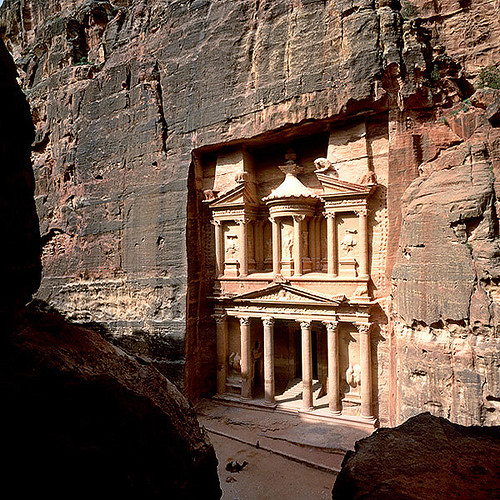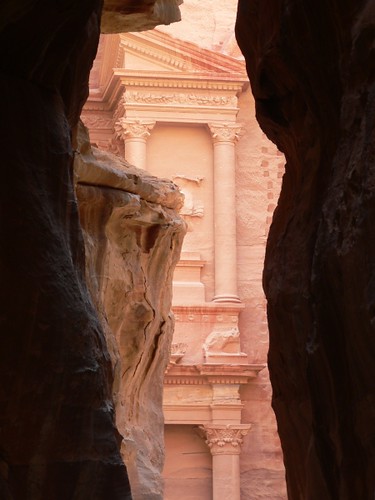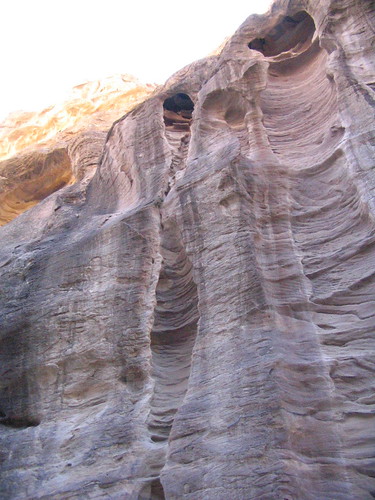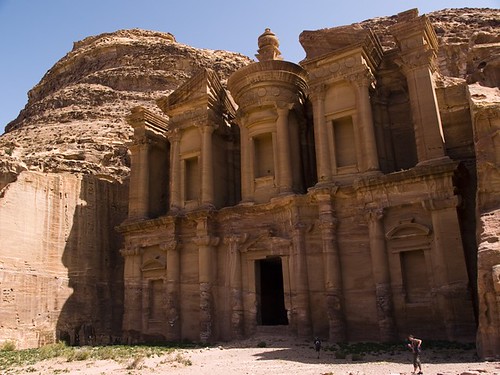Petra~One Of The New 7 Wonders Of The World
 Petra (from πέτρα "petra," rock in Greek; Arabic: البتراء, Al-Butrā) is an archaeological site in Jordan, lying in a basin among the mountains which form the eastern flank of Arabah (Wadi Araba), the large valley running from the Dead Sea to the Gulf of Aqaba. It is well known that many structures of stone carved in the rocks. The long-hidden site was revealed to the Western world by the Swiss explorer Johann Ludwig Burckhardt in 1812. It was famously described as "a rose-red city half as old as time" in a Newdigate prize-winning sonnet by John William Burgon. Burgon had not actually visited Petra, which remained accessible only to Europeans accompanied by local guides with armed escorts until after World War I. The site was designated as a UNESCO World Heritage Site in 1985 when it was described as "one of the most precious cultural properties of man's cultural heritage."
Petra (from πέτρα "petra," rock in Greek; Arabic: البتراء, Al-Butrā) is an archaeological site in Jordan, lying in a basin among the mountains which form the eastern flank of Arabah (Wadi Araba), the large valley running from the Dead Sea to the Gulf of Aqaba. It is well known that many structures of stone carved in the rocks. The long-hidden site was revealed to the Western world by the Swiss explorer Johann Ludwig Burckhardt in 1812. It was famously described as "a rose-red city half as old as time" in a Newdigate prize-winning sonnet by John William Burgon. Burgon had not actually visited Petra, which remained accessible only to Europeans accompanied by local guides with armed escorts until after World War I. The site was designated as a UNESCO World Heritage Site in 1985 when it was described as "one of the most precious cultural properties of man's cultural heritage."Geography
Rekem is an ancient name for Petra and appears in Dead Sea scrolls such as 4Q462 associated with Mount Seir. Additionally, Eusebius and Jerome (Onom. sacr. 286, 71. 145, 9; 228, 55. 287, 94) assert that Rekem was the native name of Petra, supposedly on the authority of Josephus (Antiquities iv. 7, 1~ 4, 7), Pliny the Elder and other writers identify Petra as the capital of the Nabataeans, Aramaic-speaking Semites, and the centre of their caravan trade. Enclosed by towering rocks and watered by a perennial stream, Petra not only possessed the advantages of a fortress but controlled the main commercial routes which passed through it to Gaza in the west, to Bosra and Damascus in the north, to Aqaba and Leuce Come on the Red Sea, and across the desert to the Persian Gulf.
 Excavations have shown that the ability of the Nabataeans, the water supply has led the increase in the desert city, in fact, the creation of an artificial oasis. The area is visited by flash floods and archaeological evidence demonstrates the Nabataeans controlled these floods by the use of dams, cisterns and water conduits. So water could be saved even during long periods of drought, and the city prospered from its sale.
Excavations have shown that the ability of the Nabataeans, the water supply has led the increase in the desert city, in fact, the creation of an artificial oasis. The area is visited by flash floods and archaeological evidence demonstrates the Nabataeans controlled these floods by the use of dams, cisterns and water conduits. So water could be saved even during long periods of drought, and the city prospered from its sale.Although in ancient times Petra might have been approached from the south (via Saudi Arabia on a track leading around Jabal Haroun, Aaron's Mountain, on across the plain of Petra), or possibly from the high plateau to the north, most modern visitors approach the ancient site from the east. The impressive eastern entrance leads steeply down through a dark and narrow gorge (in places only 3–4 metres wide) called the Siq (the shaft), a natural geological feature formed from a deep split in the sandstone rocks and serving as a waterway flowing into Wadi Musa. At the end of the narrow gorge stands Petra's most elaborate ruin, Al Khazneh ("the Treasury") hewn directly out of the sandstone cliff.
 A little farther from the Treasury, at the foot of the mountain called en-Nejr is a massive theatre, so placed as to bring the greatest number of tombs within view. At the point where the valley opens out into the plain, the site of the city is revealed with striking effect. The amphitheatre has actually been cut into the hillside and into several of the tombs during its construction. Rectangular gaps in the seating are still visible. Almost enclosing it on three sides are rose-colored mountain walls, divided into groups by deep fissures, and lined with knobs cut from the rock in the form of towers.
A little farther from the Treasury, at the foot of the mountain called en-Nejr is a massive theatre, so placed as to bring the greatest number of tombs within view. At the point where the valley opens out into the plain, the site of the city is revealed with striking effect. The amphitheatre has actually been cut into the hillside and into several of the tombs during its construction. Rectangular gaps in the seating are still visible. Almost enclosing it on three sides are rose-colored mountain walls, divided into groups by deep fissures, and lined with knobs cut from the rock in the form of towers.History
 So far, no method has been found to determine when the story of Petra began. There are indications that the city was established relatively late, although there may be a sanctuary since very ancient times. This part of the country was traditionally assigned to the Horites, probably cave-dwellers, the predecessors of the Edomites. The habits of the original natives may have influenced the Nabataean custom of burying the dead and offering worship in half-excavated caves. However, the fact that Petra is mentioned by name in the Old Testament cannot be verified. Although Petra is usually identified with Sela which also means a rock, the Biblical references are not clear. 2 Kings xiv. 7 seems to be more specific. In the parallel passage, however, Sela is understood to mean simply "the rock" (2 Chr. xxv. 12, see LXX). As a result, many authorities doubt whether any town named Sela is mentioned in the Old Testament.
So far, no method has been found to determine when the story of Petra began. There are indications that the city was established relatively late, although there may be a sanctuary since very ancient times. This part of the country was traditionally assigned to the Horites, probably cave-dwellers, the predecessors of the Edomites. The habits of the original natives may have influenced the Nabataean custom of burying the dead and offering worship in half-excavated caves. However, the fact that Petra is mentioned by name in the Old Testament cannot be verified. Although Petra is usually identified with Sela which also means a rock, the Biblical references are not clear. 2 Kings xiv. 7 seems to be more specific. In the parallel passage, however, Sela is understood to mean simply "the rock" (2 Chr. xxv. 12, see LXX). As a result, many authorities doubt whether any town named Sela is mentioned in the Old Testament.It is unclear exactly what Semitic inhabitants called their city. Apparently on the authority of Josephus (Antiquities of the Jews iv. 7, 1~ 4, 7), Eusebius and Jerome (Onom. sacr. 286, 71. 145, 9; 228, 55. 287, 94), assert that Rekem was the native name and Rekem appears in the Dead Sea scrolls as a prominent Edom site most closely describing Petra. But in the Aramaic versions Rekem is the name of Kadesh, implying that Josephus may have confused the two places. Sometimes the Aramaic versions give the form Rekem-Geya which recalls the name of the village El-ji, southeast of Petra. The capital, however, would hardly be defined by the name of a neighboring village. The Semitic name of the city, if not Sela, remains unknown. The passage in Diodorus Siculus (xix. 94–97) which describes the expeditions which Antigonus sent against the Nabataeans in 312 BC is understood to throw some light upon the history of Petra, but the "petra" referred to as a natural fortress and place of refuge cannot be a proper name and the description implies that the town was not yet in existence. Brünnow thinks that "the rock" in question was the sacred mountain en-Nejr (above). But Buhl suggests a conspicuous height about 16 miles north of Petra, Shobak, the Mont-royal of the Crusaders.
 More satisfactory evidence of the date of the earliest Nabataean settlement may be obtained from an examination of the tombs. Two types may be distinguished—the Nabataean and the Greco-Roman. The Nabataean type starts from the simple pylon-tomb with a door set in a tower crowned by a parapet ornament, in imitation of the front of a dwelling-house. Then, after passing through various stages, the full Nabataean type is reached, retaining all the native features and at the same time exhibiting characteristics which are partly Egyptian and partly Greek. Of this type there exist close parallels in the tomb-towers at el-I~ejr in north Arabia, which bear long Nabataean inscriptions and supply a date for the corresponding monuments at Petra. Then comes a series of tombfronts quit, in a semicircular arc, a feature from northern Syria. Finally, the elaborate facades copied from the front of a Roman temple. But all traces of the indigenous style disappeared. The exact dates of the phases of this development can not be repaired. Strangely, some inscriptions have been found at any length Petra, perhaps lost because they are compatible with stucco or cement was used on many of the buildings. The simple pylon tombs, which belong to the pre-Hellenic Age serve as evidence for the earliest time. It is not known how far back at this stage of Nabataean settlement, but it goes no further back than the 6th Century BC.
More satisfactory evidence of the date of the earliest Nabataean settlement may be obtained from an examination of the tombs. Two types may be distinguished—the Nabataean and the Greco-Roman. The Nabataean type starts from the simple pylon-tomb with a door set in a tower crowned by a parapet ornament, in imitation of the front of a dwelling-house. Then, after passing through various stages, the full Nabataean type is reached, retaining all the native features and at the same time exhibiting characteristics which are partly Egyptian and partly Greek. Of this type there exist close parallels in the tomb-towers at el-I~ejr in north Arabia, which bear long Nabataean inscriptions and supply a date for the corresponding monuments at Petra. Then comes a series of tombfronts quit, in a semicircular arc, a feature from northern Syria. Finally, the elaborate facades copied from the front of a Roman temple. But all traces of the indigenous style disappeared. The exact dates of the phases of this development can not be repaired. Strangely, some inscriptions have been found at any length Petra, perhaps lost because they are compatible with stucco or cement was used on many of the buildings. The simple pylon tombs, which belong to the pre-Hellenic Age serve as evidence for the earliest time. It is not known how far back at this stage of Nabataean settlement, but it goes no further back than the 6th Century BC. A period follows in which the dominant civilization combines Greek, Egyptian and Syrian elements, clearly pointing to the age of the Ptolemies. Towards the close of the 2nd century BC, when the Ptolemaic and Seleucid kingdoms were equally depressed, the Nabataean kingdom came to the front. Under Aretas III Philhellene, (c.85–60 BC), the royal coins begin. The theatre was probably excavated at that time, and Petra must have assumed the aspect of a Hellenistic city. In the reign of Aretas IV Philopatris, (9 BC–AD 40), the fine tombs of the el-I~ejr [?] type may be dated, and perhaps also the great High-place.
A period follows in which the dominant civilization combines Greek, Egyptian and Syrian elements, clearly pointing to the age of the Ptolemies. Towards the close of the 2nd century BC, when the Ptolemaic and Seleucid kingdoms were equally depressed, the Nabataean kingdom came to the front. Under Aretas III Philhellene, (c.85–60 BC), the royal coins begin. The theatre was probably excavated at that time, and Petra must have assumed the aspect of a Hellenistic city. In the reign of Aretas IV Philopatris, (9 BC–AD 40), the fine tombs of the el-I~ejr [?] type may be dated, and perhaps also the great High-place.Some video clips from You Tube :
Video from Metacafe about Petra, Jordan :
The Red-Rose City
No comments:
Post a Comment